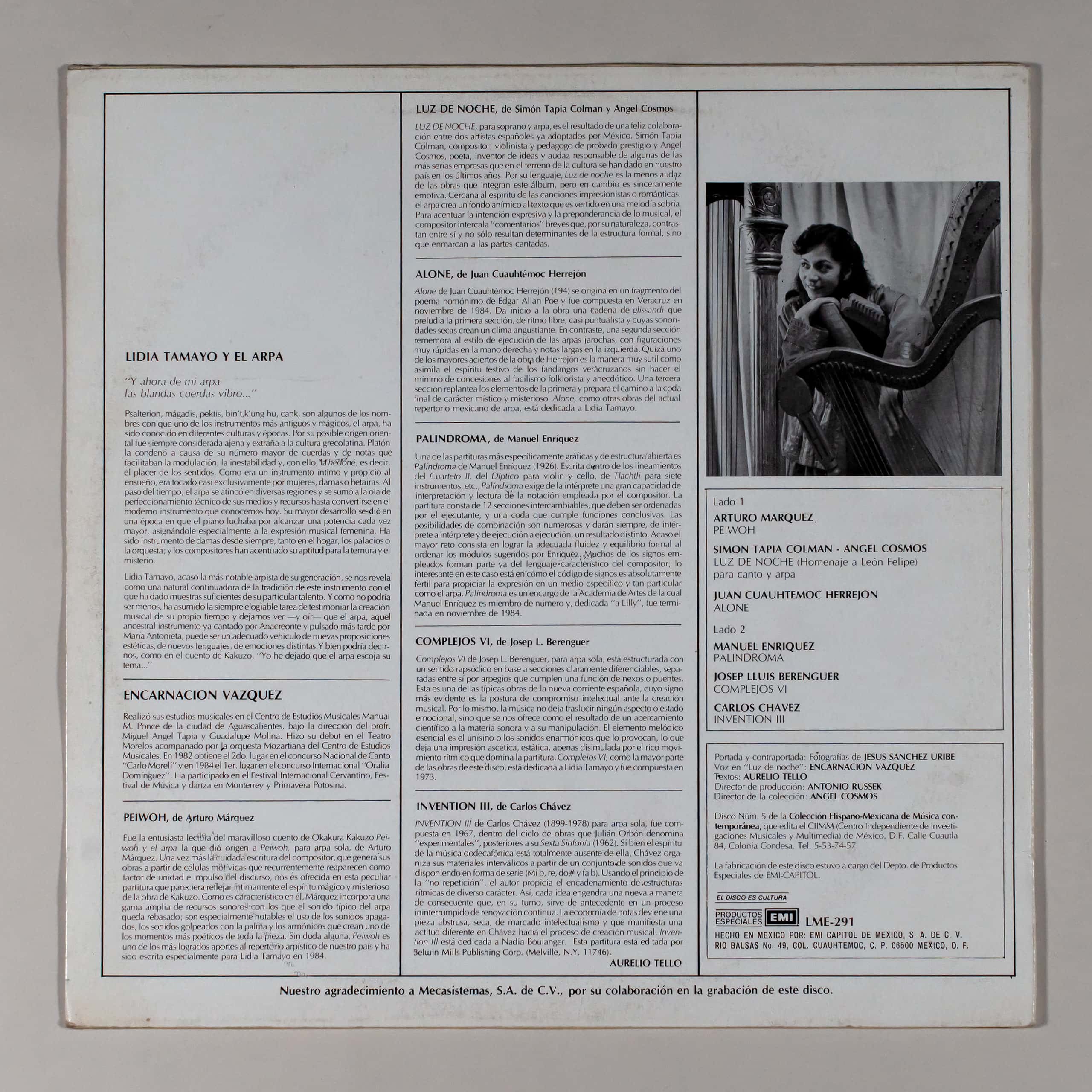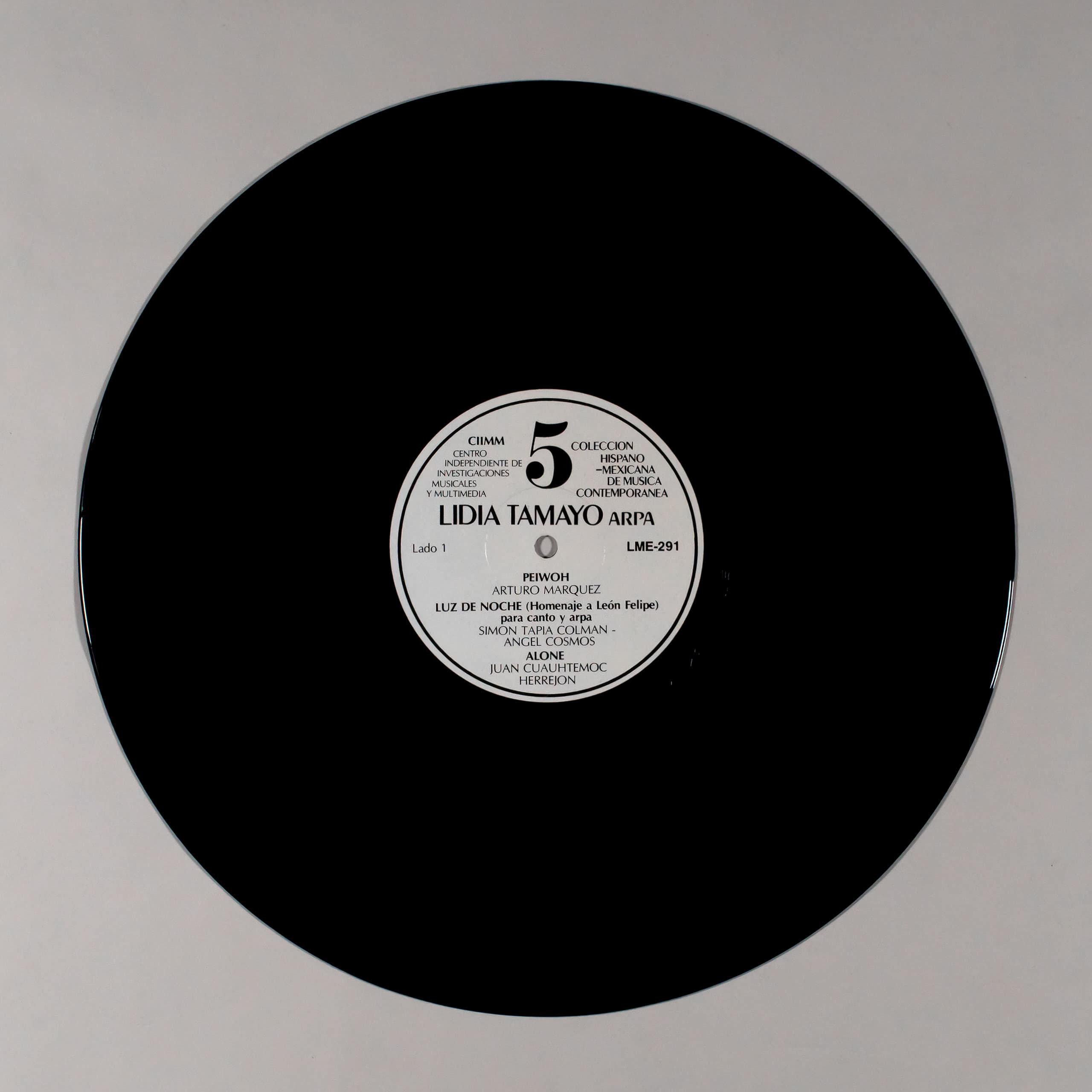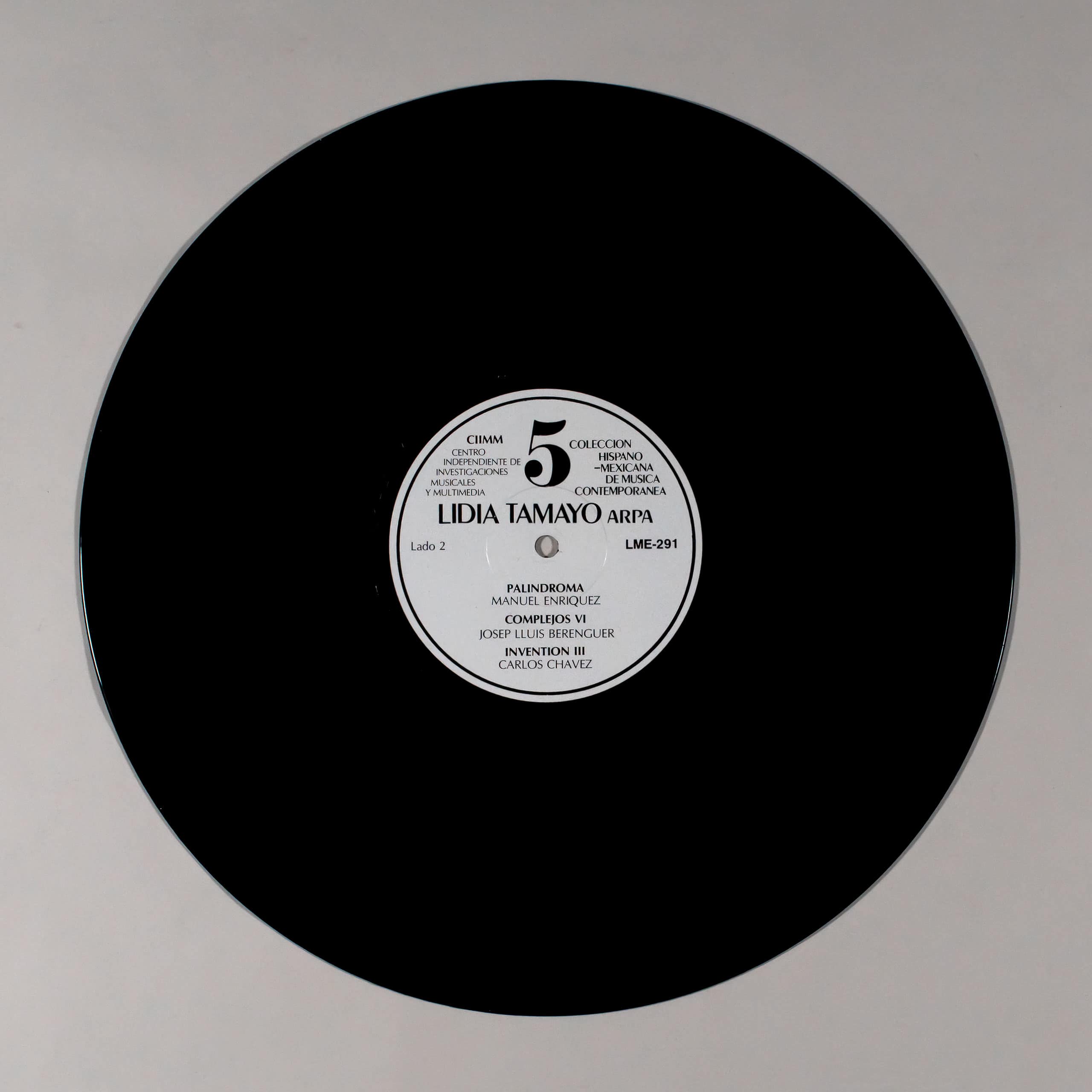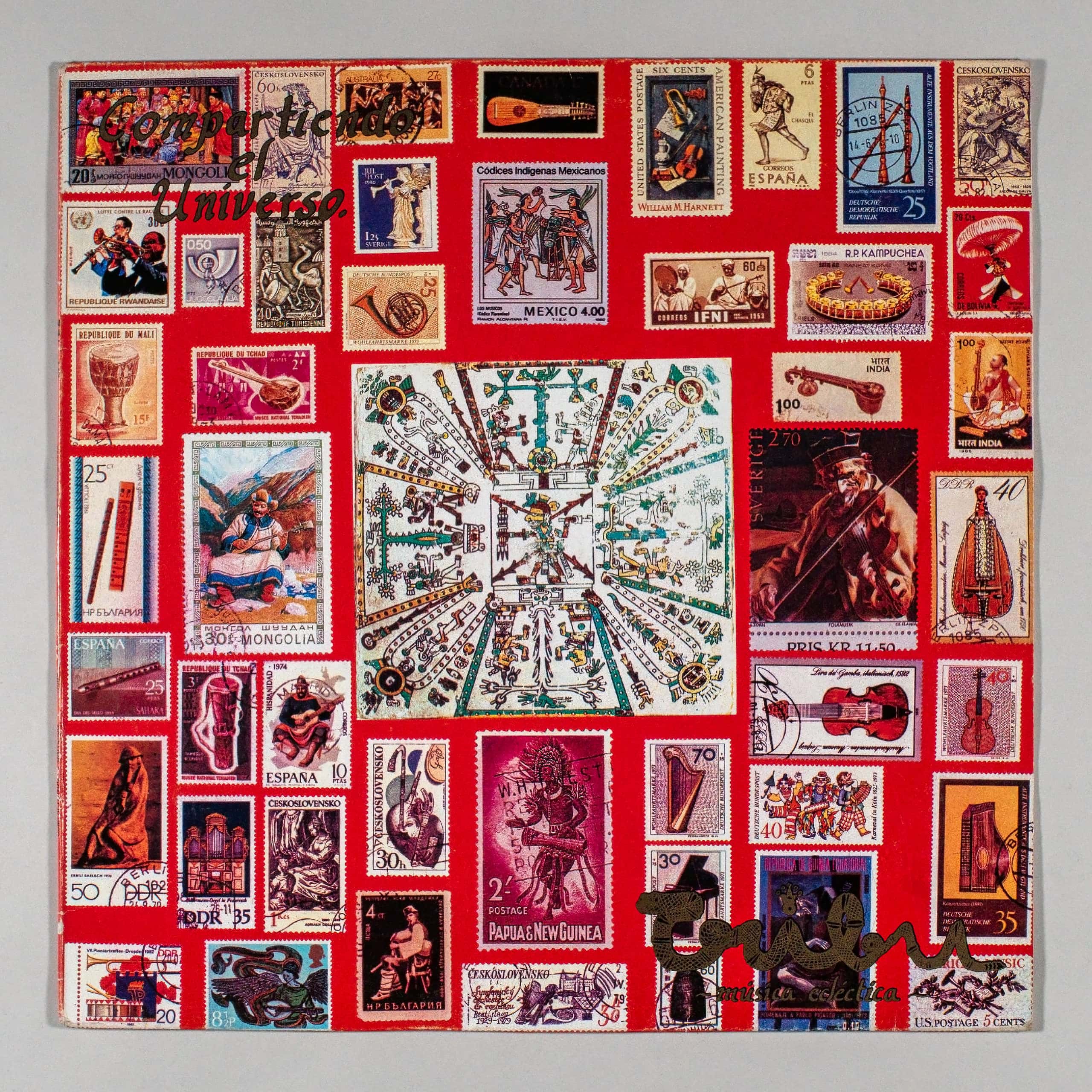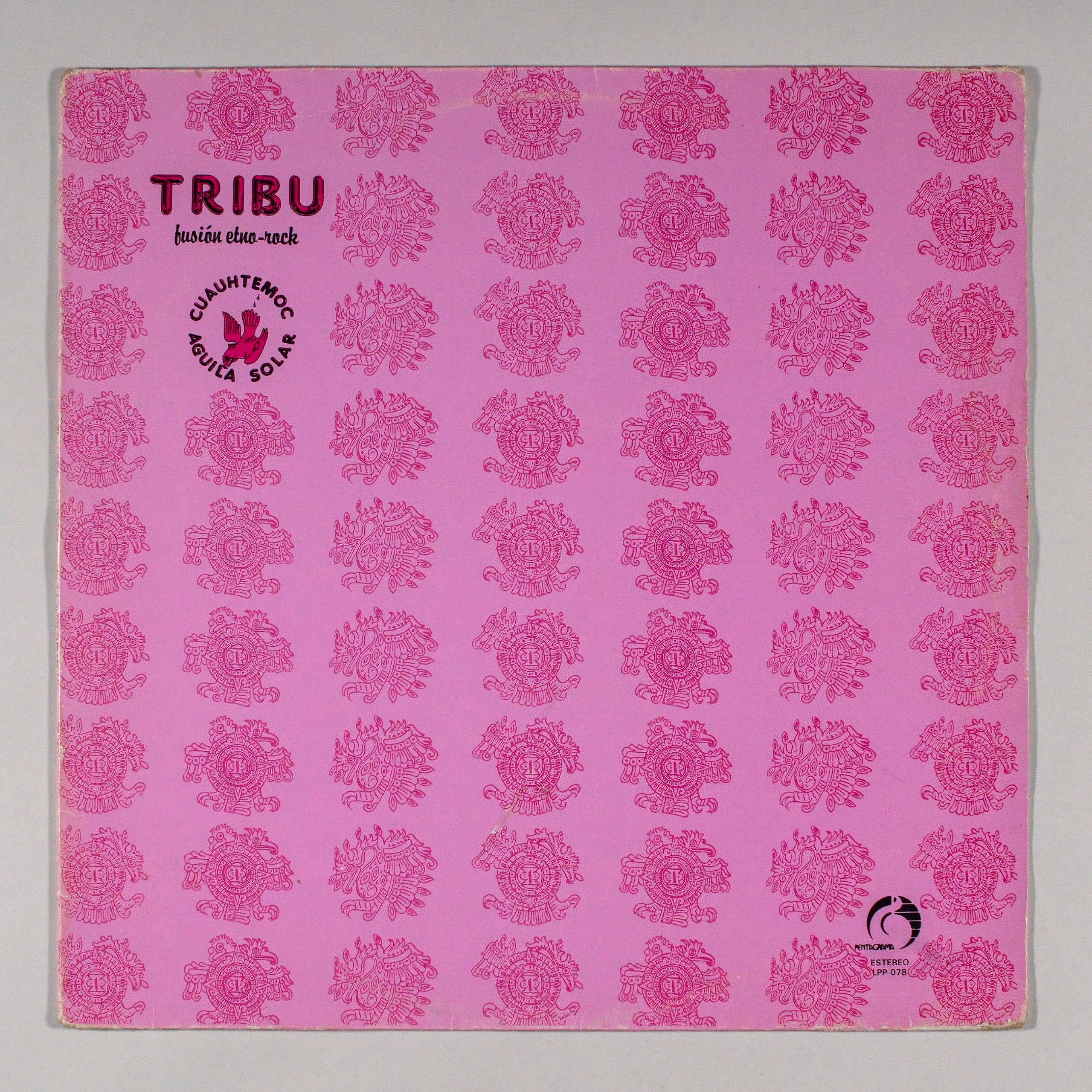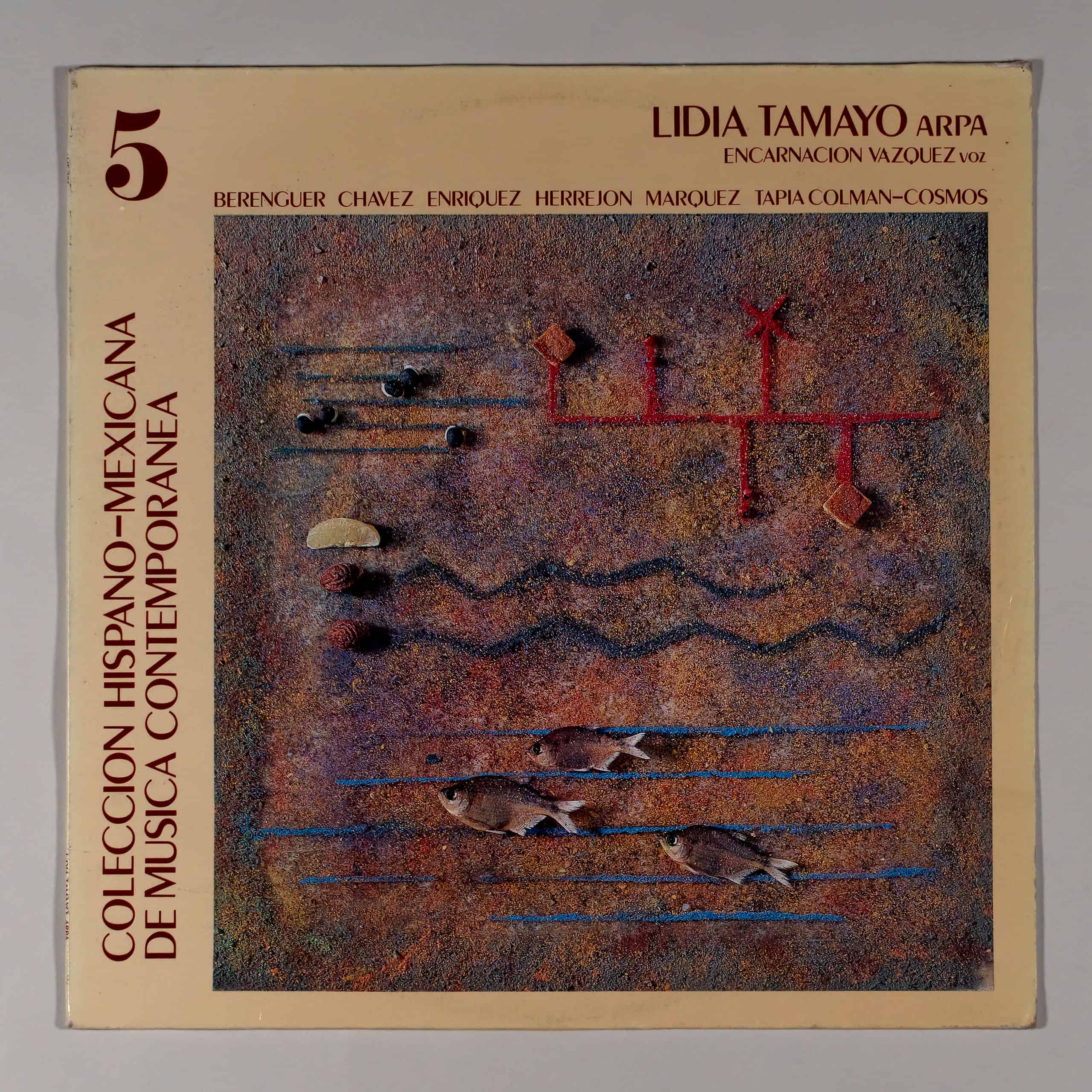
|
Format: Vinyl LP 12" 33 1/3 rpm Released: 1986 |
Country: Mexico |
Info:
HISPANIC-MEXICAN CONTEMPORARY MUSIC COLLECTION 5
LIDIA TAMAYO HARP
ENCARNACIÓN VÁZQUEZ VOICE
BERENGUER CHAVEZ ENRIQUEZ HERREJON MARQUEZ TAPIA COLMAN-COSMOS
LIDIA TAMAYO AND THE HARP
“And now of my harp
the soft strings vibrate…”
Psalterion, mágadis, pektis, bin’t, k’ung hu, cank, are some of the names by which one of the oldest and most magical instruments, the harp, has been known in different cultures and times. Due to its possible oriental origin, it was always considered alien and strange to the Greco-Roman culture. Plato condemned it because of its greater number of strings and notes that facilitated modulation, instability and, with it, ta hedoné, that is, the pleasure of the senses. As it was an intimate instrument conducive to dreams, it was played almost exclusively by women, ladies or hetairas. Over time, the harp settled in various regions and joined the wave of technical improvement of its means and resources until it became the modern instrument we know today. Its greatest development occurred at a time when the piano was struggling to reach greater power, assigning it especially to female musical expression. It has always been a ladies’ instrument, both in the home, the palaces or the orchestra; and composers have accentuated his flair for tenderness and mystery.
Lidia Tamayo, perhaps the most notable harpist of her generation, reveals herself to us as a natural continuator of the tradition of this instrument with which she has shown sufficient evidence of her particular talent. And as it could not be less, he has assumed the always laudable task of bearing witness to the musical creation of his own time and letting us see –and hear– that the harp, that ancestral instrument already sung by Anacreon and played later by Marie Antoinette, can be an adequate vehicle of new aesthetic propositions, of new languages, of different emotions. And she could well tell us, as in Kakuzo’s tale, “I have let the harp choose her triplet…”
ENCARNACION VAZQUEZ
He completed his musical studies at the Manual M. Ponce Center for Musical Studies in the city of Aguascalientes, under the direction of prof. Miguel Angel Tapia and Guadalupe Molina. She made her debut at the Teatro Morelos accompanied by the Mozartiana orchestra of the Centro de Estudios Musicales. In 1982 he obtained the 2nd. place in the National Song Contest “Carlo Moreli” and in 1984 the 1st. place in the International contest “Oralia Domínguez”. He has participated in the International Cervantino Festival, Music and Dance Festival in Monterrey and Primavera Potosina.
PEIWOH, by Arturo Márquez
It was the enthusiastic reading of Okakura Kakuzo’s wonderful story Peiwoh and the harp that gave rise to Peiwoh, for solo harp, by Arturo Márquez. Once again the careful writing of the composer, who generates his works from motive cells that repeatedly reappear as a factor of unity and impulse of the discourse, is offered to us in this peculiar score that seems to intimately reflect the magical and mysterious spirit of the work of Kakuzo. As is characteristic of him, Márquez incorporates a wide range of sound resources with which the typical sound of the harp is surpassed; especially notable is the use of muffled sounds, palm-struck sounds, and harmonics that create one of the most poetic moments of the entire piece. Without a doubt, Peiwoh is one of the most accomplished contributions to our country’s artistic repertoire and has been written especially for Lidia Tamayo in 1984.
NIGHT LIGHT, by Simón Tapia Colman and Angel Cosmos
LUZ DE NOCHE, for soprano and harp, is the result of a happy collaboration between two Spanish artists already adopted by Mexico. Simón Tapia Colman, composer, violinist and educator of proven prestige; and Angel Cosmos, poet, inventor of ideas and daring person in charge of some of the most serious undertakings that have taken place in our country in recent years in the field of culture. Because of its language, Luz de noche is the least audacious of the works that make up this album, but instead it is sincerely emotional. Close to the spirit of impressionist or romantic songs, the harp creates a moody background for the text that is poured into a sober melody. To accentuate the expressive intention and the preponderance of the musical, the composer inserts brief “comments” that, by their nature, contrast with each other and are not only determinants of the formal structure, but also frame the sung parts.
ALONE, by Juan Cuauhtémoc Herrejon
Alone by Juan Cuauhtemoc Herrejon (1943) originates from a fragment of Edgar Allan Poe’s poem of the same name and was composed in Veracruz in November 1984. The work begins with a chain of glissando that preludes the first section, with a free rhythm, almost punctualist and whose dry sonorities create a distressing climate. In contrast, a second section recalls the playing style of jarocho harps, with very fast figurations in the right hand and long notes in the left. Perhaps one of the greatest successes of Herrejon’s work is the very subtle way in which he assimilates the festive spirit of the fandangos from Veracruz without making the minimum of concessions to folkloristic and anecdotal ease. A third section restates the elements of the first and paves the way for the final coda of a mystical and mysterious nature. Alone, like other works of the current Mexican harp repertoire, is dedicated to Lidia Tamayo.
PALINDROMA, by Manuel Enriquez
One of the most specifically graphic and open-structured scores is Palindroma by Manuel Enríquez (1926). Written within the guidelines of Quartet II, the Diptych for violin and cello, Tlachtli for seven instruments, etc., Palíndroma demands from the performer a great ability to interpret and read the notation used by the composer. The score consists of 12 interchangeable sections, which must be ordered by the performer, and a coda that fulfills concluding functions. The combination possibilities are numerous and will always give, from interpreter to interpreter and from execution to execution, a different result. Perhaps the greatest challenge consists in achieving the appropriate fluidity and formal balance when ordering the modules suggested by Enriquez. Many of the signs used are already part of the composer’s characteristic language; What is interesting in this case is how the code of signs is absolutely fertile to foster expression in a specific and particular medium such as the harp. Palíndroma is commissioned by the Academy of Arts of which Manuel Enríquez is a full member and, dedicated “to Lilly”, was completed in November 1984.
COMPLEJOS VI, by Josep L. Berenguer
Complejos VI by Josep L. Berenguer, for solo harp, is structured in a rhapsodic sense based on clearly distinguishable sections, separated from each other by arpeggios that serve as links or bridges. This is one of the typical works of the new Spanish trend, whose most obvious sign is the position of intellectual commitment to musical creation. For this reason, music does not reveal any aspect or emotional state, but is offered to us as the result of a scientific approach to sound matter and its manipulation. The essential melodic element is the unison or the enharmonic sounds that provoke it, which leaves an ascetic, static impression, barely concealed by the rich rhythmic movement that dominates the score. Complejos VI, like most of the works on this album, is dedicated to Lidia Tamayo and was composed in 1973.
INVENTION III, by Carlos Chávez
INVENTION III by Carlos Chávez (1899-1978) for solo harp, was composed in 1967, within the cycle of works that Julián Orbón calls “experimental”, after his Sixth Symphony (1962). Although the spirit of twelve-tone music is totally absent from it, Chávez organizes his intervalic materials from a set of sounds that he arranges in a series (Mi b, re, do # and fa b). Using the principle of “non-repetition”, the author favors the chaining of rhythmic structures of different character. Thus, each idea engenders a new one as a consequence that, in turn, serves as an antecedent in an uninterrupted process of continuous renewal. The economy of notes becomes an abstruse, dry piece, with a marked intellectualism and that manifests a different attitude in Chávez towards the process of musical creation. Invention III is dedicated to Nadia Boulanger. This sheet music is published by Belwin Mills Publishing Corp. (Melville, N.Y. 11746).
AURELIO TELLO
SIDE 1
ARTURO MARQUEZ
PEIWOH
SIMON TAPIA COLMAN – ANGEL COSMOS
LUZ DE NOCHE (Homage to Leon Felipe) for song and harp
JUAN CUAUHTEMOC HERREJON
ALONE
SIDE 2
MANUEL ENRIQUEZ
PALINDROME
JOSEP LLUIS BERENGUER
COMPLEXES VI
CARLOS CHAVEZ
INVENTION III
Front and back cover: Photographs by JESÚS SÁNCHEZ URIBE
Voice in “Night Light”: ENCARNACIÓN VÁZQUEZ
Texts: AURELIO TELLO
Production manager: ANTONIO RUSSEK
Director of the collection: ÁNGEL COSMOS
Record No. 5 of the Hispano-Mexican Collection of Contemporary Music, published by the CIIMM (Independent Center for Musical and Multimedia Research) of Mexico, D.F. Cuautla Street 84, Colonia Condesa. Tel. 5-53-74-57
The manufacture of this record was in charge of the Dept. of EMI-CAPITOL Special Products.
THE DISCO IS CULTURE
SPECIAL PRODUCTS EMI LME-291
MADE IN MEXICO BY: EMI CAPITOL DE MEXICO, S. A. DE C. V.
RIO BALSAS No. 49, COL. CUAUHTEMOC, C.P. 06500 MEXICO, D.F.
Our thanks to Mecasystems, S.A. de C.V., for their collaboration in the recording of this album.
Tracklist:
LIDIA TAMAYO – HARP, ENCARNACION VAZQUEZ – VOICE
SIDE 1
- A1 Peiwoh, By Arturo Marquez
Performer(s): Lidia Tamayo – Harp, Encarnacion Vazquez – Voice - A2 Night Light (Homage To Leon Felipe) For Singing And Harp, By Simon Tapia Colman And Ángel Cosmos
Performer(s): Lidia Tamayo – Harp, Encarnacion Vazquez – Voice - A3 Alone, By Juan Cuauhtemoc Herrejon
Performer(s): Lidia Tamayo – Harp, Encarnacion Vazquez – Voice
SIDE 2
- B1 Palindroma, By Manuel Enriquez
Performer(s): Lidia Tamayo – Harp, Encarnacion Vazquez – Voice - B2 Vi Complexes, By Josep Lluís Berenguer
Performer(s): Lidia Tamayo – Harp, Encarnacion Vazquez – Voice - B3 Invention III, By Carlos Chavez
Performer(s): Lidia Tamayo – Harp, Encarnacion Vazquez – Voice
Credits:
Front and back cover: Photographs by JESUS SANCHEZ URIBE
Voice in “Night Light”: ENCARNACION VAZQUEZ
Texts: AURELIO TELLO
Production manager: ANTONIO RUSSEK
Director of the collection: ANGEL COSMOS
Notes:
Record No. 5 of the Hispano-Mexican Collection of Contemporary Music, published by the CIIMM (Independent Center for Musical and Multimedia Research) of Mexico, D.F. Cuautla Street 84, Colonia Condesa. Tel. 5-53-74-57
The manufacture of this record was in charge of the Dept. of Special Products of EMI-CAPITOL.
MADE IN MEXICO BY: EMI CAPITOL DE MÉXICO, S. A. DE C. V.
Our thanks to Mecasystems, S.A. de C.V., for their collaboration in the recording of this album.







